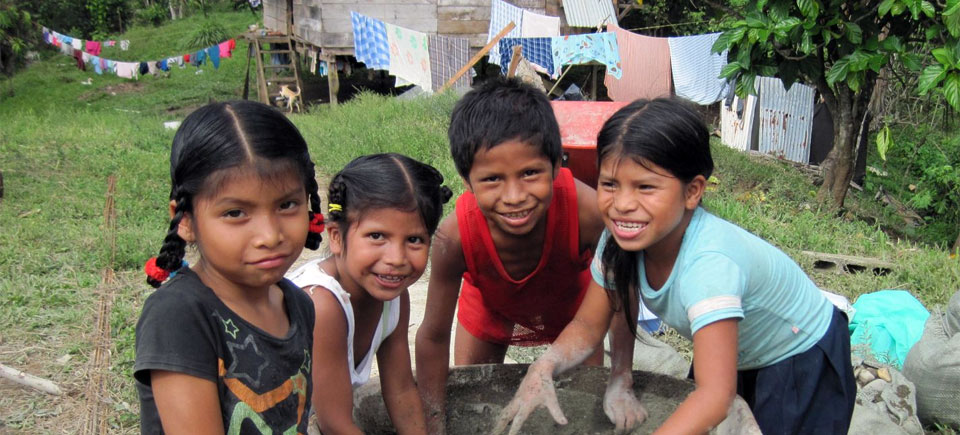Three University of Nevada, Reno students knew they had all they needed when they traveled in January to the small Panamanian village of Valle Escondido.
They were there to help the locals built composting latrines from the ground up.
Graduate students Murphy Gardner and Angela Stevens and undergraduate Julie Ruiz had all the basic materials on hand.
But the three students provided something a little less material and a little more inspirational, that was, looking back on the trip, probably just as important.
"We provided the funds and materials, of course, and we also provided ... the motivation," said Gardner, a 26-year-old member of the University's hydrologic sciences graduate program and also a member of the student organization, Student Association for International Water Issues (SAIWI). "It gave us such a good feeling to be helping the village ... and the people really seemed to appreciate it.
"It felt like our enthusiasm and motivation was really helpful to them."
"It was so nice to see the people there get so excited about the project, and the fact that we were there to help them," said Stevens, also 26 and a member of SAIWI and the hydrologic sciences program. Stevens was recently awarded the Caesars Foundation Fellowship in Watersheds and Environmental Sustainability as part of her work with the Desert Research Institute.
Valle Escondido has about 350 residents who are indigenous Ngobe, a group of more than several thousand people who live primarily in western Panama. Their village, whose name is translated roughly as "Hidden Valley," is located on San Cristobal Island in Bocas Del Toro, Panama.
"It's a very rural community with no electricity and little infrastructure," Stevens said.
"They have a gravity-fed system of PVC for running water," Gardner added. "None of the luxuries like refrigeration."
The SAIWI students, along with help from Peace Corps volunteer Patricia Wilbur, brought bags of sand and gravel, cement and chicken wire with the hope of building one or possibly two composting latrines for the village.
When the students' two-week visit was over, three latrines were built. Both Stevens and Gardner praised their undergraduate sidekick, Ruiz, who is majoring in ecohydrology, for her upbeat and positive "can-do" personality.
"Julie was really great," Stevens said. "She had the greatest attitude and was super-excited to be there."
"The entire trip," Gardner added, "she seemed to be saying, 'And what else can we do?'"
In addition to the construction work, the students distributed duffels of clothes to the residents.
"We did a clothing drive (in Reno)," Stevens said. "We had duffel bags full of clothes and shoes for them."
The trip, Gardner said, was a clear reminder of how indigenous people such as the Ngobe of Valle Escondido get by with what would be considered so little in the United States.
"You might get a little stressed in your professional life here in the United States, and then you'll think about Panama and the little village of Valle Escondido and the luxuries we have by comparison," he said.
"And yet, everyone there was just so positive. They've learned to patiently deal with life."
Nothing was more emblematic of the warmth of the people and the success of the trip than the students' last night in the village. The villagers held a going away party. By 7 p.m., it was already getting dark. But with the help of a small generator, the village's single CD player played relatively uninterrupted. The revelers danced to the light of two lanterns, one solar and one powered by the only battery in the village.
"That was our dancing light," Stevens said. "And it was great."
Both Stevens and Gardner said the experience was one they wouldn't soon forget.
"One of the things I'll always remember was one of the men in the village, who said that night, 'Now I have family in the U.S.,'" Stevens said.
"It was a successful trip in every way," added Gardner, whose tall, fair complexion earned him the nickname "Garza" or "Garza Blanca" - tall white heron - from the locals. "It was just a wonderful experience in every way."
(Editor's note: Both Stevens and Gardner mentioned that a key SAIWI fundraiser for water and sanitation projects in Panama, Kenya and the Navajo Nation will be held soon. The 10th annual Ron Petersen African Dinner will be held on Saturday, March 9, at the California Building in Idlewild Park. Doors open at 6 p.m. The event includes African cuisine, entertainment, silent auction and raffle and trip presentations. Tickets are $40, $25 for students.












